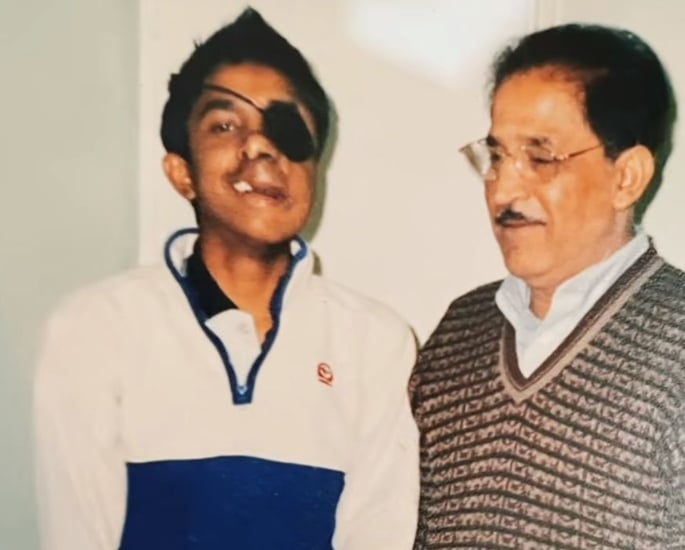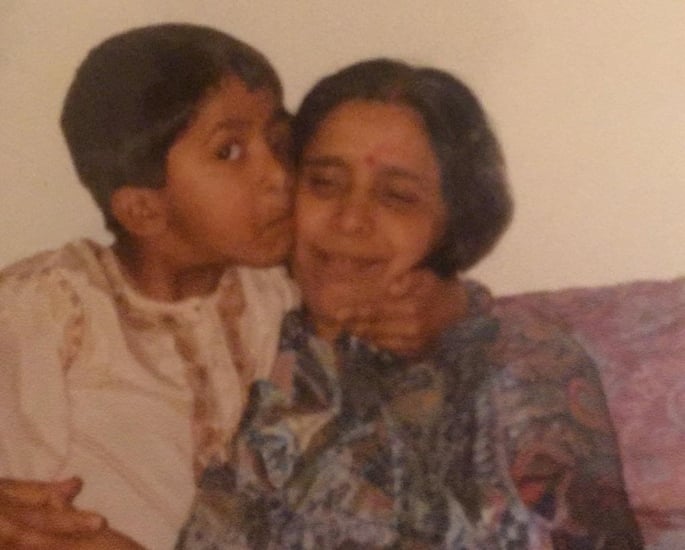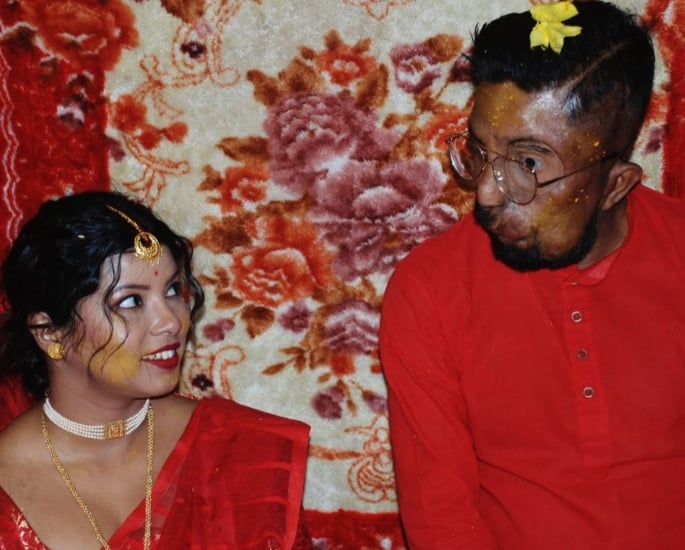Amit Ghose: Visually Different, Bullied at School & Inspiring a Generation
Amit Ghose, who was born with neurofibromatosis type one, bravely shares his personal account, shedding light on his experiences and the challenges he has faced throughout his life.
Visual disfigurement is a challenging reality faced by individuals around the world.
In South Asian communities, this topic remains largely taboo, leading to stigmatisation and discrimination against those with certain conditions.
Despite the difficulties he encountered, Amit has made it his mission to create a positive impact and raise awareness about his condition.
From childhood to adulthood, he has confronted the fear of being accepted.
Within his own family, community and friends circle, he’s faced countless acts of emotional and mental bullying.
This is a far too familiar situation for South Asians who deal with certain conditions, disabilities, or illnesses.
So, in order to spark a major discussion and incite change, we spoke to Amit Ghose about his lived experiences and the importance of challenging societal norms.
Early Challenges and Community Resentment


From an early age, Amit Ghose experienced the harsh realities of living with a visible condition.
During his primary school years, he was confronted with stares, fear, and rejection from his peers.
Students often distanced themselves from him, driven by their own insecurities and the fear of being associated with someone different.
The emotional toll of these experiences left Amit feeling anxious and depressed as he explains:
“Primary school was very difficult for me at many stages. Going into school the first day and having all those children stare at you, look at you, and be scared of you was painful.
“I have very sort of vague memories of people not wanting to sit next to me or be my friend.
“They were either scared of me or thought actually if I’m going to be his friend, the cooler kids won’t be my friend. So they decided they’d rather not be my friend.
“It was just very, very difficult and upsetting to be going to school.
“Obviously at that age, you don’t know what depression is, you don’t know what anxiety is.
“But looking back now, I can say very much, I was anxious and felt depressed going into school.
“People used to call me ‘blobby cheek’ or ‘one-eyed wonder’, because I used to have a big eyelid covering my real eyes.
“So, they’re like, ‘oh here’s the one-eyed freak’.
“Because I couldn’t see from the left side of my face, I used to have people sitting next to me putting their fingers up at me from the left ’cause I couldn’t see them.
“Suddenly the whole class would be laughing and I wouldn’t know why, and then I’d suddenly realised that there’s this kid just making rude gestures to me.”
Within Amit’s wider community, there was a pervasive sense of resentment and blame.
Some individuals held Amit’s parents accountable, believing they must have committed some wrongdoing to have a child with a visible condition.


Amit acknowledges that staring and judgment, particularly within the Asian community, are prominent challenges faced by individuals with visible differences.
There is often a stigma or taboo associated with being different, leading to prejudices.
Amit recounts instances of judgment and negative comments from the community, including conversations about his marriage prospects:
“I think in my wider community there was definitely a sense of resentment.”
“There was a lot of blame on my parents as if my parents must have sinned in their life to give birth to a child like this.
“When we used to have guests coming into the house and I knew they had young children with them, I would hide.
“I’d be scared to come down and see that family because I know that child is gonna react either in fear.
“The judgment was a lot when I was younger, but as I grew up, the finger started pointing at me.
“I remember there was one incident before I got married.
“I was at a wedding and a group of aunties were saying which father or mother would give their daughter away to me.
“And in the same wedding, someone had a conversation with me about arranged marriages and said ‘it’d be nice if we could find you someone from back home’.
“They said ‘put yourself in the father’s shoes, would you want to marry someone who looks like you?’.
“And this person was talking to me one-on-one, and I was thinking how is he having this conversation with me?.
“Then he said ‘we just feel that if it wasn’t for your condition, then you might have found somebody’.”
In such a hostile and judgemental environment, these conversations and thoughts became too common for Amit Ghose.
And it speaks volumes about South Asian communities that place such importance on appearance.
Not only does it take away from someone’s personality, but it also makes it tougher to deal with societal pressures for those with visual differences.
Despite these misconceptions, Amit’s father played a pivotal role in instilling a sense of normality and acceptance in his son.
By treating Amit no differently from his other children, his father helped him realise that societal prejudices should not dictate one’s self-worth.
Marriage and Mental Health


Amit recognises the profound impact that his journey has had on his mental health and his outlook on life.
He openly discusses the emotional struggles he faced and why it was tough for him to navigate through situations.
While he questioned “why me” in front of the mirror countless times, he realised that he couldn’t change his physical appearance.
Instead, he chose to change his mindset and outlook on life. Eventually, he managed to meet his wife online.
However, this wasn’t without its own complications and Amit’s insecurity shone through:
“When we first started talking and video calling, I’d only show her half of my face on the video calls.
“And the moment I knew she was the right person is the day she said to me, ‘look, I’m not gonna marry half of your face. I’m gonna marry all of you. So quit hiding your face.
“That’s the day I knew that she means something to me.”
Although Amit’s wife was very accepting of his neurofibromatosis, her family and the community in India were not.
He explains how his marriage process was a nightmare and emphasised just how ridiculed he felt:
“Her family were dead against this.
“Her family said ‘we categorically do not want you to marry this man. How are we gonna show our face to the community?’.
“I mean, her mum didn’t even come to the wedding.
“The whole thing leading up to our wedding was really traumatising for me because I knew I’m getting all this rejection because of the way I look.
“I had to prove that this condition isn’t gonna affect my life expectancy. I had to go to my doctor and get a letter to say this.”


He emotionally continues to say:
“These are personal conversations that me and my wife need to be having, not before my wedding with her whole extended family.
“It was really difficult, really, really difficult.
“There were many times before the wedding when my wife broke down in tears. She was torn.
“A lot of people in my family never thought I’d get married.”
“And I’ve had this conversation with my family members, a lot of them were worried that someone would marry me to take advantage of me.
“I remember on my wedding day, we were in this temple and standing in a queue to get married.
“And literally there were people standing right in front of me with their phones, taking pictures of my face.
“The place got crowded threefold than it usually was because people were phoning each other saying there’s a man here who looks really funny.
“Another moment I clearly remember was during the time I was getting my wife’s passport done.
“We had to get a lot of verifications done, so we had to go to the police station a lot.
“It was a female receptionist that was sitting there and she’d made no eye contact with me.
“She just handed me some paper and said ‘go and fix it’. She didn’t give me any advice.
“Thankfully there was somebody around who was quite helpful and said I needed to photocopy these documents and sign them.
“When I came back to the desk, she got up and said, ‘oh my God, I’m feeling ill. I’m feeling really sick’.
“As we were walking off, my wife said to me that the receptionist asked who I was to her. My wife replied ‘my husband’.
“The receptionist said ‘you married that?’.
“Not even ‘him’, she said ‘that’
“And that’s the kind of comments you get when you are in India. You get it here as well but it amplifies in India.”
Although Amit Ghose had come to terms with his condition and appearance, moments like this made it very difficult to carry on as normal.
With such a distaste from the people of his own culture toward him, it highlights what other South Asians with visual differences have to go through.
Although Amit’s marriage was successful and a joyous occasion, some of the memories from the process are far from happy.
TikTok and Self-Acceptance


For Amit, confidence is not about conforming to societal standards of beauty or physical appearance.
Instead, it is about embracing individuality, accepting oneself, and recognising inner strengths.
A pivotal moment in Amit’s journey came with his first TikTok video.
Inspired by conversations at networking events, where his confidence and attitude attracted attention, Amit decided to make TikTok videos sharing confidence tips.
One day, while walking down the street and noticing people staring, he realised the need to spread a message about the inappropriateness of staring.
His initial video garnered a significant response, encouraging Amit to create more content and further amplify his positive message.
“I made a video and posted it. Within 24 hours it reached over 50,000 people.
“My followers went up and I thought, this is great, let’s do more of this. People are receiving this and welcoming this in a good way.
“When I started TikTok and I posted my first video, my wife asked me ‘what do you want to achieve from this?’.
“I said if I can impact one person’s life positively and if one person can come and say to me, ‘thanks’, I think that will mean a lot to me.
“About two weeks into me posting my videos, somebody sent me a message on TikTok.
“They said ‘Amit, you’re really inspirational, really motivating. Thank you.
“She told me she had tumours and has the same condition as me.
“She said she’s got tumours on her hands and thighs, and she can never wear short sleeves or go swimming and it upsets her.
“I said well you can do all those things.
“But she said her friends are going to judge her.
“But let’s be real, if someone’s going to judge you for a few tumours and it’s stopping you from going out swimming and enjoying yourself, do you really want those friends?
“Two weeks after she sent me a message again. She put on her Facebook and her social media that she’s got these tumours, and she’s got an NF1.
“She took pictures of her arms and stuff. And it turns out that her supervisor also has the same condition.
“I asked her how she felt and she used the word ‘epic’.
“A week after she posted a picture of her in a bikini on holiday. And it made me so proud to see that picture.”
Through his TikTok platform and other social media channels, Amit has become a beacon of inspiration for countless individuals facing similar challenges.
His content focuses on boosting confidence, spreading awareness, and advocating for inclusivity.
His engaging videos, heartfelt messages, and relatable experiences have resonated with a wide audience, empowering others to embrace their uniqueness and defy societal expectations.
In addition to his work on social media, Amit Ghose actively engages in public speaking and educational initiatives.
He collaborates with organisations and schools to raise awareness about neurodiversity, challenge misconceptions, and promote inclusivity.
When asked about if things have improved over the course of his journey, he replied:
“There’s a lot of engagement and people are learning and people are changing and people are becoming more accepting.”


He also highlighted some advice that he wishes to share with others if they’re dealing with visual differences or any other conditions that are harming their mental health:
“If someone says to me they’ve got a visible difference and they’re struggling, the first thing I say is, ‘have you accepted your difference?’.
“Have you looked in the mirror and said to yourself, this is who I am, this is how I am. Have you done that yet? If you haven’t, try and do that first. It’s not easy.
“It’s not going to happen overnight. It didn’t happen overnight for me.
“There are many days now where suddenly I ask myself, ‘oh, why me?’.
“But it starts with acceptance. It starts with saying, yes, I am who I am, and I celebrate that.”
“I think it’s the people around you as well, like I touched on my father.
“I didn’t get that special treatment because if I had, then I would’ve felt I’m special, I need help.
“But because they dealt with me the way everyone else dealt with me, I had that feeling of independence.”
Finally, through his inspiring words, Amit Ghose hinted at his plans for the future:
“My goal is to go out and talk more publicly about the challenges of living with visible differences, with the aim to help support and inspire people.”
Amit’s journey continues to evolve, and he has ambitious plans for the future.
He aims to expand his advocacy work by partnering with more organisations and reaching a broader audience.
Amit envisions creating workshops and programs that promote confidence-building and self-acceptance, particularly for young people facing visible differences.
He believes in the power of storytelling and hopes to amplify the voices of others who have triumphed over adversity.
Amit’s inspiring journey of overcoming challenges and redefining confidence serves as a testament to the resilience of the human spirit.
Through his personal experiences, advocacy efforts, and dedication to spreading positivity, he has become a role model for individuals facing visible differences.
Amit’s story reminds us all of the importance of acceptance, self-love, and embracing the unique qualities that make us who we are.
Amit’s journey highlights the need for more action within South Asian communities and the need for safer spaces to encourage inclusivity, in all aspects.
Check out Amit Ghose’s TikTok here.
If you or know someone affected/dealing with visual differences then reach out for support to Changing Faces.